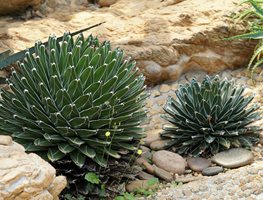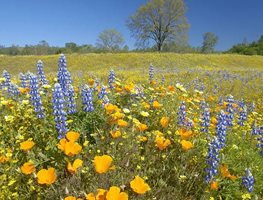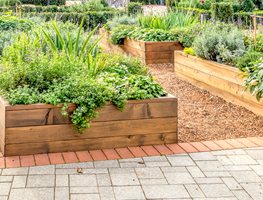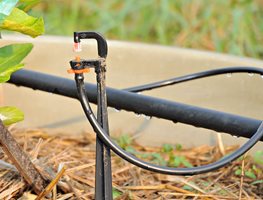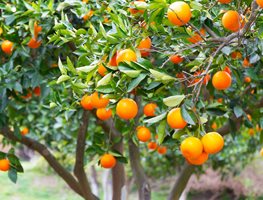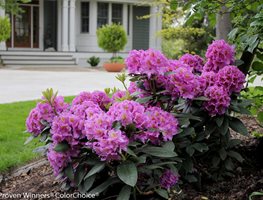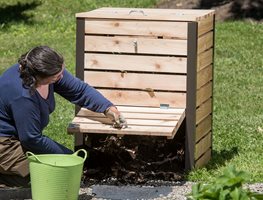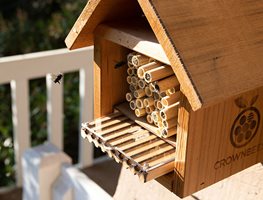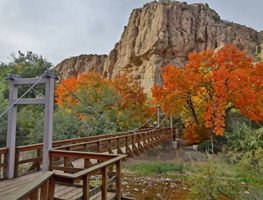10 Gardening Activities for September in the Southwest
Here are a few garden reminders, inspiring ideas, and maintenance suggestions for this month.
1. Transplant Agaves and Other Succulents
Fall is a good time to cut agave pups from the mother plant and replant them. Be sure to use a sharp, clean knife to cut the underground branches. Let branches callus over before replanting (it’s good to do this in a shaded location so plants don’t dry out). After 2 to 3 days, the pups can be planted in pots filled with cactus mix to establish roots. Be sure to keep new plants watered regularly after replanting. Once roots are established, after 4 to 6 weeks, the new plants can be planted in your garden. Learn more about growing and caring for agaves. If you want to add new agaves and succulents to your garden you can find interesting varieties online at Mountain Crest Gardens.
2. Plant Other Southwest Natives
There are a wide range of beautiful native plants in the Southwest. Many are available at local nurseries while others may need to be grown from seed. Some of the best Southwest natives include creosote bush (Larrea tridentata), Joshua tree (Yucca brevifolia), Perry’s agave (Agave parryi), red yucca (Hesperaloe parviflora), ocotillo (Fouquieria splendens), desert willow (Chilopsis linearis), spineless prickly pear (Opuntia ellisiana), pink muhly (Muhlenbergia capillaris), blue grama (Bouteloua gracilis), and beaked yucca (Yucca rostrata). You can include native wildflowers in your fall planting, too. Many seed suppliers sell mixes to scatter: try Native Southwest Wildflower Seed Mix from American Meadows.
3. Plant Herbs
Most herbs can deal with heat quite well as long as they get plenty of water. Plant herbs in raised beds, garden beds, or containers this month. Herbs should produce through the fall if you live in a frost-free zone. If plants begin to flower, pinch back flowers so plants continue producing tasty foliage. Some herbs can grow perennially in gardens with year-round warm weather: rosemary, sage, lavender, oregano, lemon verbena. Learn more about indoor and outdoor herb gardens, and get a list of 15 easy herbs to grow.
4. Adjust Irrigation
Cooler temperatures in fall mean some plants need less water to thrive. You do need to continue deep watering trees and shrubs, though. Check your irrigation schedules to make sure you’re not overwatering—if you’re getting consistent rainfall then cut back on watering days. There are also smart timers such as Rachio that adjusts watering schedules automatically based on local weather data. You can also adjust the schedule manually from an app if you prefer.
For more helpful information, see Irrigation 101.
5. Fertilize Citrus Trees
You should fertilize your citrus trees in September for the last time. The University of Arizona Cooperative Extension has a helpful chart on how to fertilize citrus trees based on tree size. This chart also notes that grapefruit and pummelo take less than the recommended amount, while lemons and limes take roughly 10% more than the recommended amounts. You should spread fertilizer throughout the root zone and not just pile it next to the tree trunk. If you’re looking to add more citrus trees to your garden, planting in late-September through early November is recommended. This timing provides cooler weather for the trees to get established before next year’s spring and summer heat. If you want to order online, check out Nature Hills (although they don’t ship to Arizona or Texas due to agriculture restrictions). If you live in Arizona, try Greenfield Citrus Nursery or Whitfill Nursery (they have three locations around Phoenix). If you want a variety of citrus to pick in your backyard, plant varieties that ripen at different times of year. This chart shows average ripening in Salt River Valley, Arizona, but it applies to all of Phoenix as well as location with similar climates and elevations.
Don't miss what to do in the garden each month, make sure you're getting our weekly newsletter.
6. Plant Now
Plant eye-catching agaves in a spot that receives plenty of sun in the garden and be sure to water once or twice a week until established. Make sure that no part of the leaf rosette is covered with soil, which can cause rotting.
Plant shrub roses in a sunny to lightly shaded site with fertile, well-draining soil that stays evenly moist for best results. You can also plant in a container, make sure the pot is at least 15 to 20 inches in diameter and 18 to 24 inches deep, with adequate drainage.
In addition to filtered shade and good drainage, plant rhododendrons and azaleas in a spot with protection from the wind. Water thoroughly before planting and position the crown of the root ball a few inches higher than the surrounding soil. In hot climates like the Southwest, fall planting allows the plant's root system to establish during the cooler months.
7. Start a Compost Heap
Building your own composting bin is an easy way to reduce waste and improve your garden. Joe Lamp’l, founder and creator of Joe Gardener, has a great video that shows how to build a compost bin using pallets. You can also buy compost bin kits or plastic bins. If you’re interested in learning more about what to put into your compost pile, check out our article: Compost 101.
8. Attract Native Bees
There are around 4,000 species of native bees in the United States. While honeybees tend to get all the glory, it’s native bees that do much of the pollination of crops and other flowers. In a study published in Science magazine, researchers found that honeybees don’t pollinate crops as efficiently alone, and that native bees along with other native insects are needed to improve fruit production. You can attract native bees and other wild insects to your garden by including more native plants (a mix of trees, shrubs, and perennials is best), installing native bee houses, and leaving some bare soil for ground-dwelling bees. If you’re interested in learning more about native bee and honey bee populations, this article from Wired provides a good introduction. And for the kiddos, print out this fun coloring page: Bee Hotel.
9. Visit the Boyce Thompson Arboretum
Yes, they're open (see more about current rules). Located in Superior, Arizona (about an hour from downtown Phoenix), the Boyce Thompson Arboretum is a great place for hiking among beautiful trees and botanical collections. The arboretum is the oldest and largest botanic garden in Arizona. Encompassing 323 acres, the arboretum has a number of trails of varying distances so there’s something for everyone. You’ll see plants from the world’s deserts, towering trees, cactus specimen, wildflowers, and great views of the desert. Check out the trail map for more information.
10. Online Learning
Go back to “garden school” this fall with online gardening courses taught by talented experts in their respective fields. One of the instructors, Nicole Burke of Gardenary, offers an 8-session course that teaches you to create kitchen gardens (and even start your own business),with examples from her own kitchen garden, as well as her clients in Texas. Also explore courses about houseplants, shade plants, gardening basics, container gardening, and more.
If you enjoyed this information, sign up for our weekly newsletter. Each week, you'll get Garden Design's best delivered right to your inbox including design tips, plant picks, great gardens, outdoor living products, and events to enjoy — along with monthly gardening checklists just for your area.
Do you know someone who would enjoy this Southwest Region gardening information? Why not share it with them?
When you purchase products through links on our site, we may receive an affiliate commission. Thank you for your support.
